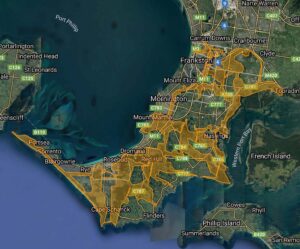Linking the Mornington Peninsula Landscape
The Linking the Mornington Peninsula Landscape (LMPL) project is an initiative that aims to reconnect fragmented remnants of Indigenous vegetation to create wildlife corridors (biolinks) on the Mornington Peninsula. LMPL assists Mornington Peninsula Landcare groups and landholders to develop collaborative local biolink plans for catchments across the Peninsula. These plans focus on works required to achieve the biolink on private properties, but also consider public land in the biolink area.
Why do we need biolinks on the Mornington Peninsula
The Mornington Peninsula is an iconic and beautiful region and is considered the most biodiverse 750 km2 in Victoria. Fragmentation of the landscape over time has led to the decline of many native birds and mammals. As native trees, shrubs, and grasslands have been cleared to make way for farms, residences, and infrastructure, mammals such as swamp wallabies, bandicoots, antechinus, echidna, and skinks have lost habitat and become vulnerable to feral cats and foxes. Many reptiles are also in decline due to loss of habitat and predation from introduced animals.
In order to be healthy, native landscapes must remain connected so that wildlife can move safely between areas of food and shelter. A landscape that is highly fragmented can trap animals in areas that are too small for their needs. Where understorey has been cleared, small mammals and birds that forage on the ground are vulnerable to predators such as cats, dogs and foxes, and their numbers decline rapidly. Those that escape predation may suffer from inbreeding (lack of genetic diversity) and their populations become vulnerable to diseases or sudden death due to disturbances such as pest outbreaks and high-intensity bushfires.
Biolinks are areas of bush and other habitat (such as waterways and stands of paddock trees) that connect areas of valuable habitat and forage. Biolinks enable wildlife to move freely and safely and have access to the broader landscape. This is increasingly important in light of climate change, as the requirement of animals to move to more suitable areas becomes critical.
Creating biolinks involves developing corridors of native vegetation on public and private property and/or (where possible) removing barriers such as electrified fences to allow for wildlife movement. A biolink can also be created by developing patches of bushland that act like ‘stepping stones’ for wildlife, reducing the distances between individual habitat patches. Some actions taken to create biolinks include weeding, planting, strategic fencing to keep out stock and feral animals and the building of underpasses and overpasses at roads to enable safe passage of wildlife.
In a fragmented (partially cleared) landscape such as the Mornington Peninsula, biolinks to assist movement of animals can be can created by developing either (a) corridors to provide a continuous connection between habitat patches; or (b) and (c) patches of bushland that act like ‘stepping stones’ for wildlife, reducing the distances between individual habitat patches.
In 2012 representatives from nine Landcare groups on the Mornington Peninsula developed a map of proposed biolinks covering the entire Peninsula. The proposed biolinks are based on an analysis of vegetation quality of the Peninsula produced by the Arthur Rylah Institute for Environmental Research. Input was sought from local natural resource management professionals and ecologists to ensure scientific integrity.

Peninsula-wide biolinks (orange shading)
Between 2014 and 2023, funded by the Natural Resorces Conservation League, the Mornington Peninsula Landcare Network has delivered the LMPL project, creating biolinks in each of the 10 catchments of the Mornington Peninsula.
- Year 1 (2014-15) Watson Creek catchment (northern Peninsula – Baxter, Somerville, Frankston South) and for Sheepwash Creek catchment (Red Hill, Dromana South)
- Year 2 (2015-2016) Main Creek catchment and Southwest Mornington Peninsula
- Year 3 (2017) Dunns Creek and Red Hill South catchment areas
- Year 4 (2020) Manton and Stony Creeks and Merricks-Coolart catchments
- Year 5 (2023) Balcombe and Moorooduc and Devilbend Hastings catchments.
As a landholder, hosting a section of biolink on your property means setting aside a portion of your land for native vegetation. You could become an active contributor to this initiative and restore a section of your land to benefit local wildlife. Enjoy watching the fruits of your labour in the future. Meet your neighbours as you learn more about the landscape you live in.
Sign up for the Linking the Mornington Peninsula Landscape Newsletter to receive regular updates.
LMPL is a project of the Mornington Peninsula Landcare Network, in partnership with the Natural Resources Conservation League.
